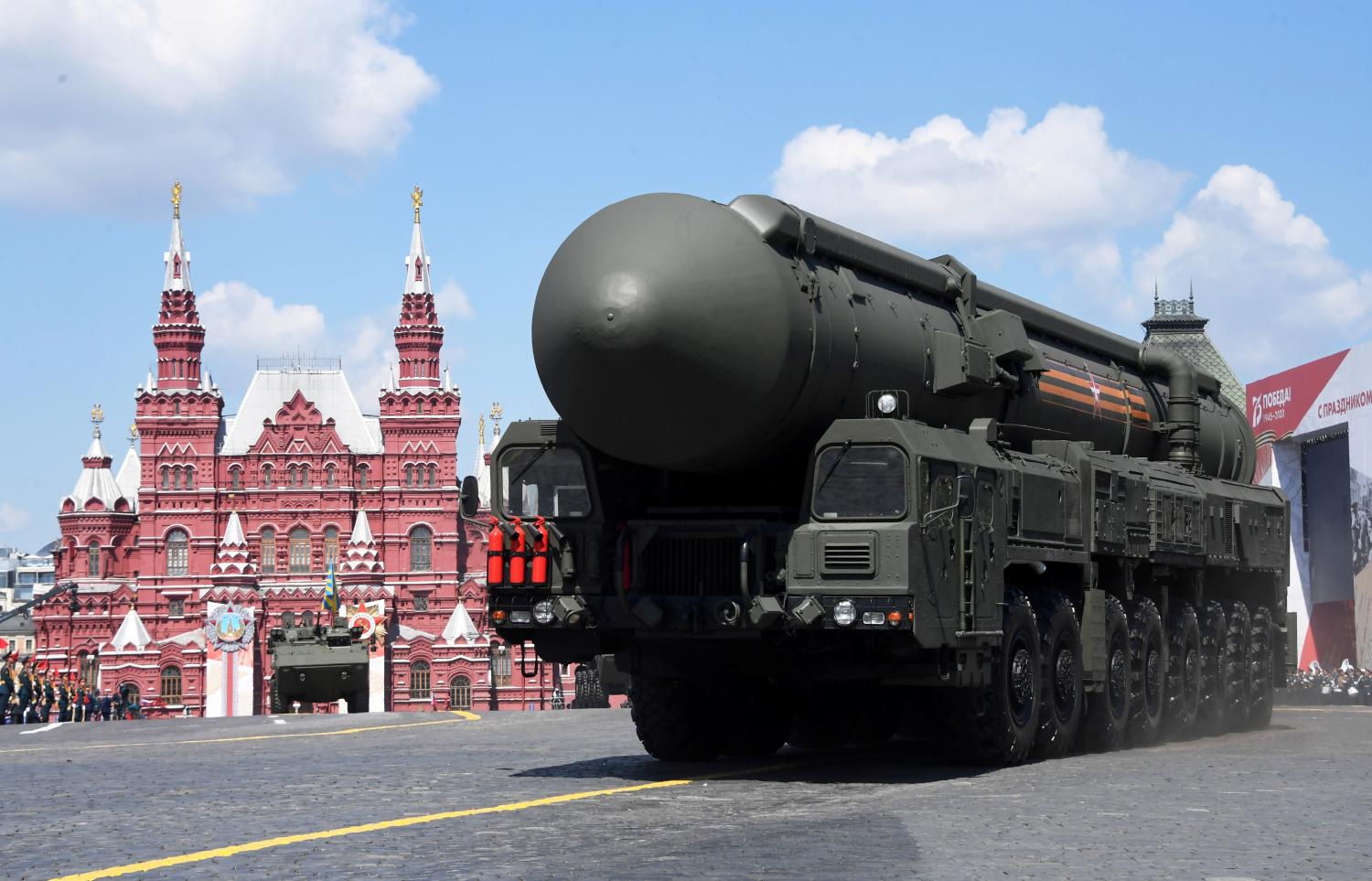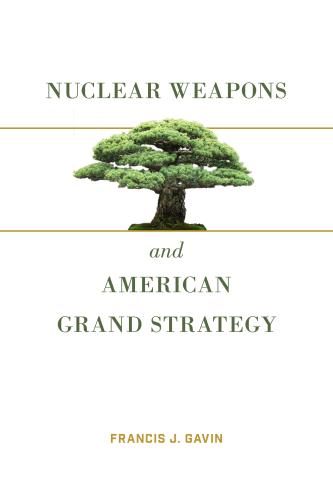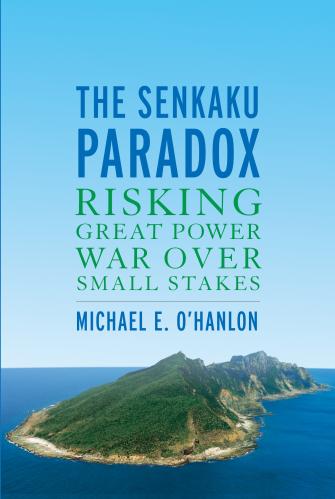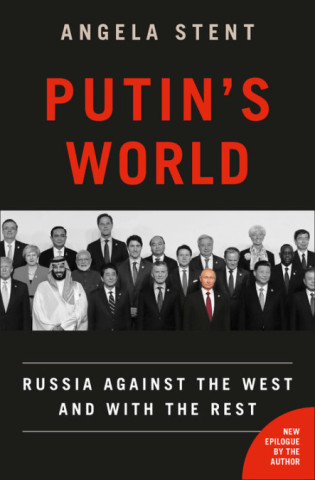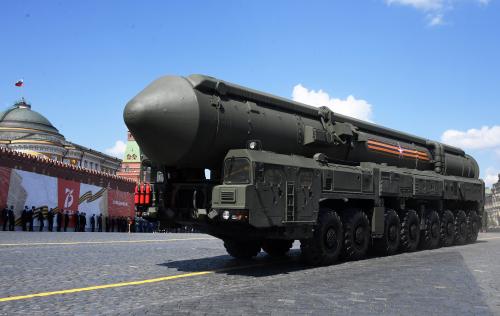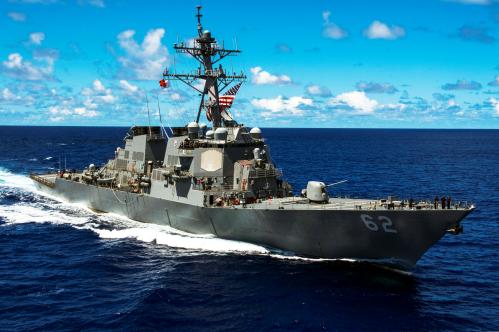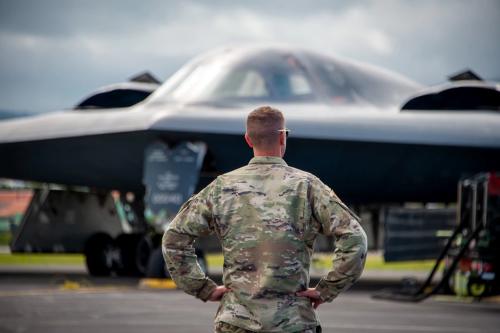This brief is part of the Brookings Blueprints for American Renewal & Prosperity project. This paper was originally published in Arms Control Today. An expanded version was published as an Occasional Paper of the James Martin Center for Nonproliferation Studies, based at the Middlebury Institute of International Studies at Monterey.
The United States will need partners to overcome the growing challenges that the global nuclear nonproliferation regime will face in the years ahead. In the past, Washington was able on several occasions to work cooperatively with Moscow and Beijing in support of shared nonproliferation goals. But with the sharp deterioration of U.S. bilateral relationships with those two major powers in recent years, that cooperation no longer exists. Despite the current acrimonious state of those relationships, the Biden administration will need to find a way to revitalize cooperative efforts on key nonproliferation issues. After restoring now-abandoned bilateral channels for constructive engagement, the administration should seek common ground with Russia and China in pursuing new negotiations with Iran, curbing the North Korean nuclear and missile threat, rebuilding collaboration in securing nuclear materials and facilities, and reinforcing the Treaty on the Non-Proliferation of Nuclear Weapons (NPT), including by promoting a successful NPT Review Conference, pursuing nuclear risk reduction measures, strengthening International Atomic Energy Agency safeguards, and coordinating nuclear export policies.
Challenge
The record of the global nuclear nonproliferation regime has been impressive, defying dire predictions of a world with many nuclear-armed states. Since North Korea acquired nuclear weapons nearly 30 years ago, no additional country has done so. Many factors explain that positive record, but one of those factors has been the ability of the United States to work constructively with Russia and China from time to time in support of shared nonproliferation goals.
However, with no end in sight to the current precipitous decline in Washington’s bilateral relations with Moscow and Beijing, constructive engagement on today’s nonproliferation challenges has become increasingly problematic. Unless the United States and its two great-power competitors can find a way to carve out areas of cooperation in otherwise highly adversarial relationships, few, if any, of those challenges can be effectively addressed, and the remarkably positive record of international efforts to prevent additional countries from acquiring nuclear weapons will be difficult to sustain.
Limits of historic and existing policies
Previous cooperation on nonproliferation
Despite periods of intense bilateral rivalry, the United States often managed to find common ground with the Soviet Union, and later with Russia and China, on preventing nuclear proliferation. At the height of the Cold War, the United States and the USSR recognized that the instabilities and dangers associated with the emergence of additional nuclear-weapon states could jeopardize their national interests, not least because it could create new power centers and undercut their own dominant positions in world affairs and, for Moscow, raise the specter of a nuclear-armed Germany.
In the Soviet era, this shared interest led to close collaboration in addressing proliferation threats, including in drafting the nuclear Nonproliferation Treaty (NPT) and establishing the London Group of nuclear exporters, which became the Nuclear Suppliers Group (NSG). Later, Washington worked with Moscow to encourage Belarus, Kazakhstan, and Ukraine to give up their Soviet-era nuclear weapons and join the NPT as non-nuclear-weapon states. They helped ensure through Nunn-Lugar Cooperative Threat Reduction programs that inadequately secured Russian nuclear materials and facilities in the wake of the USSR’s collapse would not leak out and support nuclear developments worldwide.1 Most recently, the United States and Russia worked with other powers to persuade Iran to accept strict limits on its nuclear programs in the Joint Comprehensive Plan of Action (JCPOA).
China was a latecomer to nonproliferation. In the nation’s early years, it publicly advocated the spread of nuclear weapons to “break the hegemony of the superpowers.” By the early 1990s, however, it had come to see considerable value in curbing proliferation. It believed that by adhering to nonproliferation norms, it could promote a more stable international environment, needed for its development; maintain the non-nuclear-weapon status of Japan and other Asian neighbors; bolster its credentials as a responsible permanent member of the U.N. Security Council; and build better relations with the United States. Accordingly, it joined the NPT and other instruments of the global nonproliferation regime.
Throughout the 1990s, frequent U.S.-Chinese engagement on nonproliferation was instrumental in encouraging Beijing to put in place its national export control system and cease proliferation-sensitive technology transfers, including any nuclear cooperation with Iran, which China agreed to forgo in exchange for a Clinton administration decision to authorize the U.S. sale of nuclear reactors to China. As host and chair of the six-party talks in the 2000s, China played an active role in pressing North Korea to halt and eliminate its destabilizing strategic capabilities. In subsequent years, China made frequent, often futile efforts at the highest levels to dissuade Pyongyang from proceeding with nuclear and missile tests and to encourage North Korea to accept negotiated limitations.
From sometimes partners to frequent foes
In recent years and especially with the sharp downturn in bilateral relations, Moscow and Beijing have increasingly acted less as Washington’s nonproliferation partners and more as opponents.
This shift has been especially pronounced with regard to Iran, with cooperation as JCPOA negotiating colleagues giving way to strong differences. To a significant extent, opposition by Russia and China to U.S. policies on Iran since 2018 has been shared by Washington’s European allies, but Chinese and Russian opposition has gone well beyond that of the Europeans. Russia and China have aligned themselves closely with Iran and become its principal defenders on most issues of contention.
With Beijing in the lead on North Korea, just as Moscow has the lead on Iran, China and Russia have increasingly distanced themselves from U.S. policy on North Korea and moved closer to Pyongyang. They believe the Trump administration’s harsh sanctions campaign has resulted in North Korea digging in its heels. Worse, they fear that U.S. policy could destabilize the North Korean regime, an outcome that China regards as threatening to its interests and one that many Chinese regard as the actual, unstated goal of U.S. policy on North Korea. Although mostly complying with U.N. sanctions in 2016–2017, Russia and China now seem determined to weaken sanctions and have become complicit in sanctions evasion. They also take issue with what they regard as an unrealistic U.S. approach to negotiations on denuclearization.
Elsewhere, Russia and China have actively opposed efforts by the United States and much of the international community to pursue Syria regarding its noncompliance with its nuclear and chemical weapons nonproliferation obligations. In the wake of Israel’s 2007 destruction of a plutonium-production reactor that North Korea was clandestinely helping Syria build, they have sought to shield Damascus from International Atomic Energy Agency (IAEA) scrutiny of Syria’s nuclear program. In the face of compelling evidence that the Assad regime has used chemical weapons against its opponents on many occasions, Russia, supported by China, has gone to great lengths to oppose efforts by the Organisation for the Prohibition of Chemical Weapons (OPCW) to attribute chemical weapons use to the Syrian government.
Russia has been the leading critic of the “state-level concept,” an IAEA approach to making its safeguards system more effective by taking into account not only information obtained through its own traditional verification activities but also information obtained from other sources, including intelligence supplied by IAEA member states. Moscow has claimed that reliance on third-party information has enabled Western countries, especially the United States, to manipulate the IAEA to serve their political goals, although Russia seems mainly concerned about information that could incriminate its allies, particularly Iran and Syria.
Reducing the risks of terrorists acquiring potentially vulnerable weapons-usable nuclear materials has been a highly successful area of nonproliferation cooperation, especially between the United States and Russia. Such nuclear security cooperation between Moscow and Washington no longer exists, in part because Russia has come to resent the image of dependence on U.S. assistance in securing materials and facilities in Russia. A critical additional factor was the sharp downturn in U.S.-Russian relations after Moscow’s 2014 annexation of Crimea, with Washington imposing sanctions in 2014 in response to Russia’s aggression against Ukraine. Moscow retaliated by pulling the plug on key nuclear security programs, and Congress prohibited U.S. funding for nuclear projects in Russia. Emblematic of the near-total breakdown of bilateral cooperation on nuclear security was Russian President Vladimir Putin’s decision not to attend the 2016 nuclear security summit hosted by U.S. President Barack Obama.
The reduction in U.S.-Chinese nuclear security cooperation in recent years has been much less dramatic, largely because such cooperation has never been as extensive as U.S.-Russian cooperation. With the downward spiral of U.S.-Chinese relations from 2016 to 2020, however, bilateral cooperation has significantly declined. Some technical, working-level contacts have persisted, but senior-level mechanisms to oversee and steer cooperative engagement no longer meet.
Obstacles to future nonproliferation cooperation
The decline in U.S. nonproliferation cooperation with Russia and China will be difficult to reverse. Clearly, the greatest obstacle is the overall deterioration of U.S. relations with its two great-power competitors. Such cooperation requires a modicum of mutual trust, but today such trust no longer exists. It requires channels of dialogue and communication, but virtually all bilateral channels have been shut down. It also requires a measure of domestic support for bilateral engagement, but public and elite opinion in Russia and China has grown extremely skeptical of the benefits of engagement with the United States, and vice versa.
The continued downturn in bilateral relations could undercut one of China’s historically strong motivations for constructive engagement on nonproliferation: a desire for better relations with the United States.
The continued downturn in bilateral relations could undercut one of China’s historically strong motivations for constructive engagement on nonproliferation: a desire for better relations with the United States. Beijing has tended to take positive nonproliferation steps when relations with Washington were good or improving and to be more uncooperative when relations were declining, especially when it was angered by U.S. actions, such as the accidental bombing of the Chinese embassy in Belgrade in 1999, which some Chinese believed was intentional, or major U.S. arms sales to Taiwan.
Another related obstacle is that Russia and China, in balancing their interest in nonproliferation against what they see as their interest in strengthening strategic relationships with friendly countries such as Iran, North Korea, and Syria, now apparently assign a higher priority to the latter relative to the former. Sensing an opportunity presented by the prospect of reduced U.S. engagement in the Middle East, Putin has sought to make Russia a major actor and broker in the region, including by intervening militarily to support Bashar Assad in the Syrian civil war and working closely with Iran to ensure Assad’s victory and undermine U.S. interests in the region. Similarly, Chinese President Xi Jinping, fearing that U.S.-North Korean and South Korean-North Korean diplomacy could leave China on the sidelines in shaping the future of the Korean Peninsula, decided in 2018 to restore close ties with Pyongyang after a period of estrangement. The growing inclination of Moscow and Beijing to solidify what they regard as strategically useful partnerships helps explain why they now often back Iran, North Korea, and Syria in key nonproliferation disputes and shield them against further harsh sanctions.
An additional obstacle to cooperation, at least in recent years, has been Russian and Chinese opposition to specific nonproliferation policies of the Trump administration. That obstacle could be somewhat reduced under a Biden administration, at least on some issues, such as Iran. On other issues, however, including Syria, the roles and methods of the IAEA and OPCW, and the utility of sanctions as a nonproliferation tool, strong differences predated the Trump administration and would likely remain.
Cooperation remains essential
At a time when U.S. nonproliferation cooperation with Russia and China has all but disappeared, challenges to the global nonproliferation regime appear to be growing.
With the JCPOA largely hollowed out and Iran rebuilding its enrichment program, fear of an Iranian nuclear weapon or at least a latent nuclear weapons capability has returned and, with it, the prospect that Saudi Arabia and perhaps others in the Middle East will pursue a matching capability.
U.S. diplomacy with North Korea has reached a dead end. Pyongyang continues to advance its nuclear and missile programs, and U.S. allies South Korea and Japan, worried by the expanding threat from the North and increasingly uncertain about the reliability of U.S. security guarantees, may rethink the option of acquiring their own nuclear deterrents.
Assertive postures by Russia and China in their respective regions have elevated the security concerns of their non-nuclear neighbors, including Japan in the case of China.
Sophisticated illicit networks trafficking in proliferation-sensitive technologies have made detection of embryonic covert nuclear programs more difficult.
In their aggressive efforts to sell nuclear reactors, some nuclear supplier governments may relax the nonproliferation controls they require their customers to accept.
Continued polarization among parties to the NPT, fueled by dissatisfaction that progress toward nuclear disarmament has stalled and concern that U.S.-Russian arms control agreements are unraveling, has impeded efforts to strengthen nonproliferation controls and could weaken the authority of the treaty as a barrier to the acquisition of nuclear weapons.
Preventing the deterioration of the global nonproliferation regime will require the restoration of cooperation among the world’s three most influential nuclear powers.
Policy recommendations
Despite the highly acrimonious state of U.S. relations with Moscow and Beijing, efforts should be made to explore prospects for nonproliferation cooperation in some key areas.
Resuming channels of engagement
A first critical step is procedural rather than substantive: establishing channels for nonproliferation consultations. Such channels existed with Russia and China during previous U.S. administrations, sometimes under the umbrella of formal, high-level bilateral mechanisms covering a wide range of issues, such as the Clinton administration’s Gore-Chernomyrdin Commission and the George W. Bush administration’s U.S.-China Strategic Economic Dialogue.
Such top-level umbrella mechanisms are probably not feasible today, at least in the immediate future. Yet, less formal, lower-profile bilateral dialogues on nonproliferation can and should be established. These dialogues should be carried out at a high but subcabinet level, such as by undersecretaries or assistant secretaries. They should be dedicated to nonproliferation and not also seek to address nuclear arms control, which should be the focus of separate consultations to allow each subject to be handled in depth in the limited time available and with the required expertise at the table. Consultations should be held on a regular basis and should operate with a minimum of publicity to increase the likelihood of more candid interactions.
If establishing dedicated bilateral mechanisms proves difficult, the countries should look for opportunities to engage on the margins of existing multilateral meetings where relevant officials are present, such as the IAEA General Conference and meetings of the five NPT nuclear-weapon states.
Pursuing new negotiations with Iran
Iran’s nuclear capabilities will remain high on the international nonproliferation agenda in 2021 and beyond. Whatever the fate of the JCPOA, Washington can be expected to seek engagement with Iran to pursue long-term restrictions on its nuclear capacity and address its destabilizing regional activities. In light of strong Iranian mistrust and resentment toward the United States over the Trump administration’s JCPOA withdrawal and “maximum pressure” campaign, it is uncertain whether and on what terms Iranian leaders will be prepared to engage, especially given political dynamics in Tehran in the run-up to the June presidential election.
To persuade Iran to come back to the negotiating table and engage constructively by not insisting on compensation for economic losses from U.S. sanctions or other unrealistic positions, the United States will need the help of its former P5+1 partners. That means rebuilding bridges destroyed by the Trump administration’s self-isolating policies, especially its futile effort to snap back previous U.N. Security Council sanctions. Regaining the support of its European allies and working closely with its Middle Eastern partners will be critical first steps, but collaboration with Russia and China will also be essential.
Although Russia and China presumably continue to agree with the United States on the goal of preventing Iran from acquiring nuclear weapons, getting them to cooperate with Washington on a new agreement will be more difficult than it was to gain their support in the JCPOA negotiations. They are more inclined now to support Iran as a strategic partner, oppose sanctions as a means of incentivizing Tehran, give Iran the benefit of the doubt on its nuclear intentions, and see the United States rather than Iran as the source of the problem.
A key factor in gaining Chinese and Russian cooperation will be the U.S. negotiating position. If Washington hopes to get them and the Europeans on board, it will need to alter its current demands and adopt an approach that Beijing and Moscow believe is a reasonable starting point for negotiations. That means confining a new agreement to the nuclear issue and not linking progress in the nuclear negotiations to important but separate efforts to address Iran’s regional activities; seeking to limit but not eliminate Iran’s uranium-enrichment program; offering sufficient and credible sanctions relief; and dropping regime change as an explicit or implicit goal of U.S. policy.
Curbing the North Korean threat
Addressing the North Korean nuclear and missile threat will also be a top U.S. goal in 2021. As in the case of Iran, however, cooperation by Russia and China is less likely now than it was just a few years ago. A consistent, long-term goal of both countries, especially China, has been to reduce the U.S. military presence and weaken U.S. alliances in East Asia. With bilateral U.S.-Chinese relations cratering and Beijing’s suspicions of a U.S. Indo-Pacific containment strategy growing, that goal has assumed greater importance and the scope for cooperation has substantially narrowed. China increasingly sees U.S. and Chinese interests on the Korean Peninsula as a zero-sum game, illustrated by Beijing’s accusation that U.S. deployment of a sophisticated missile defense system in South Korea and other U.S. military responses to the North Korean nuclear threat are aimed largely at China.
Nonetheless, while strengthening their ties with Pyongyang and parting ways with the United States on enforcement of sanctions, Russia and China continue to share Washington’s interest in a peaceful, nuclear weapons-free Korean Peninsula, an outcome that would have the benefit, from their perspective, of reducing Washington’s need to respond to North Korean capabilities in a way they would regard as threatening, such as a major buildup of U.S. missile defenses.
Finding common ground on a negotiated solution will require the three countries, especially the United States and China, to modify their current positions. For Washington, that means accepting that denuclearization is a long-term, step-by-step process; that Pyongyang will have to be provided meaningful incentives at each step of the way; and that the first step will be a partial measure with no reliable guarantee that the goal of complete denuclearization will eventually be realized. For Beijing, it means recognizing that it will have to lean heavily on North Korea to get it to accept strict and verifiable measures and that, even if an agreement can be reached that reduces the North Korean threat, the United States and its allies will continue to reinforce their capabilities to deter the North. Russia will need to add its weight to Chinese efforts to encourage more flexible North Korean negotiating behavior. It will also need to work bilaterally with Washington, given their unique arms control experience, to demonstrate to Pyongyang that effective verification measures can be implemented without compromising national security interests.
Revitalizing nuclear security and nuclear energy cooperation
Nuclear security is the most promising area for resuming U.S. cooperation with Russia and China largely because the three countries have a genuine common interest in preventing terrorists from getting their hands on the materials needed to make nuclear weapons or dirty bombs.
Moreover, U.S.-Russian reengagement would be facilitated by the long history of cooperation in this area, by the close personal and institutional ties that developed during that long history, and by the apparent desire of technical experts on both sides to resume cooperation. The United States and China do not have the extensive record of nuclear security cooperation shared by Washington and Moscow, but neither do they have the accumulated resentments and internal opposition toward such cooperation that came to bedevil U.S.-Russian nuclear security programs.
If U.S.-Russian nuclear security cooperation is to be resurrected, it will have to abandon the past donor-recipient relationship and become a more equal partnership, with both sides sharing best practices rather than Russia simply adopting U.S. practices and with each side able to derive the benefits it seeks. That means not only pursuing the nuclear security agenda favored by the United States, but also cooperating in the fields of nuclear science and nuclear energy that the Russian nuclear establishment seeks. Furthermore, it would be useful to recognize if not welcome that Russia’s interest in cooperative projects will often depend on its calculation of commercial gain. A study by prominent U.S.- and Russian-based think tanks has recommended an extensive menu of possible future cooperation that includes developing the next generation of safe and reliable nuclear reactors, creating proliferation-resistant nuclear fuels, improving the safety of nuclear power plants, improving nuclear security and accounting technologies, and enhancing nuclear security in other countries embarking on nuclear energy programs.
Despite the termination of most U.S.-Russian nuclear security cooperation, the two countries have managed to continue as co-chairs of the Global Initiative to Combat Nuclear Terrorism (GICNT), a multilateral partnership dedicated to strengthening the capacity of its members to prevent, detect, and respond to acts of nuclear terrorism. In the months and years to come, they should look for opportunities to expand cooperation, perhaps initially under the umbrella of multilateral forums such as GICNT and IAEA-sponsored conferences, but eventually by setting up dedicated bilateral mechanisms and reestablishing a legal framework for cooperation.2
Resuming and expanding U.S.-Chinese nuclear security cooperation may face fewer hurdles than U.S.-Russian cooperation. Unlike in the case of Russia, there is a legal framework still in place, the 1997 Agreement on the Peaceful Uses of Nuclear Technology, and an ongoing mechanism that could provide a venue for expert discussions on a range of nuclear security issues. That venue is China’s Center of Excellence, created with U.S. assistance in 2016 for nuclear security exchanges and training. Future cooperation could build on such past efforts as the establishment of a radiation detection training center, a “Megaports Initiative” to enhance detection capability at Shanghai’s container port, and technical exchanges on implementing nuclear export controls. In addition, it could build on previous collaborative work in converting Chinese-built Miniature Neutron Sources Reactors, first in China and then in Ghana and Nigeria, to operate with low-enriched uranium.
Strengthening the NPT regime
The United States and Russia, and China after it joined the NPT in 1992, have been strong supporters of the treaty, and they continue to have a common interest in ensuring that it will remain an effective barrier to nuclear proliferation. Their support has been most evident at NPT review conferences, held every five years, at which the United States, China, and Russia, joined by France and the United Kingdom (the other two NPT nuclear-weapon states) have traditionally banded together to promote successful conference outcomes and to defend their records against criticism from non-nuclear-weapon states-parties that they are not doing enough to fulfill their treaty obligations to pursue nuclear disarmament.
The worsening of bilateral relations among the five, however, has led to a cracking of that solidarity. In preparations for the 2020 review conference, loud recriminations among the five, especially between the United States and Russia, have contributed to a pessimistic outlook for the conference.
- Reducing nuclear dangers. To promote a successful 2020 review conference, which was postponed until 2021 by the COVID-19 pandemic, Washington, Moscow, and Beijing should set aside their differences and seek common ground, including on issues related to nuclear disarmament. Agreement by the United States and Russia to extend the New Strategic Arms Reduction Treaty would do much to improve conference prospects. So would the beginning of U.S.-Chinese strategy stability talks, which could help avoid a destabilizing arms competition and reduce the likelihood of inadvertent armed conflict between the two world powers, even if Beijing continues its unwillingness to negotiate formal limits on its nuclear forces.
- Cooperating in the P5 process. The P5 process, a consultative mechanism initiated in 2009 to facilitate cooperation among the NPT’s five nuclear-weapon states, has so far produced useful but modest results, such as a glossary of key nuclear terms. To demonstrate to non-nuclear-armed states that they are serious about fulfilling their NPT obligation to reduce nuclear dangers, the five have begun turning to more strategically important efforts, including an in-depth dialogue on nuclear doctrines and policies and an examination of nuclear risk reduction measures. Given the current absence of bilateral channels for strategic engagement, the United States should make the most of the process. Despite the multilateral nature of the process, it can provide a venue for informal bilateral contacts.
- Fixing the NPT withdrawal problem. The United States, Russia, and China should take the lead in reinforcing the effectiveness of the NPT. A major contribution would be to correct one of the treaty’s main shortcomings: if a party exercises its right to withdraw, IAEA safeguards on its nuclear facilities and materials automatically lapse, leaving it legally entitled to use the facilities and materials it acquired under the treaty in a nuclear weapons program. Several past proposals for addressing this problem have had broad support, including among the nuclear-weapon countries, but were never adopted. With some NPT parties now hinting at withdrawal and possibly considering a run for nuclear weapons, the three countries should work together to fix it.
- Strengthening IAEA safeguards. Russia and the United States could also give a significant boost to the IAEA safeguards system by resolving their differences on the agency’s state-level concept. As recommended by a distinguished group of U.S. and Russian experts, the IAEA should make clear that although intelligence and other information supplied by member states can play an important role in helping to direct and focus the agency’s resources and activities, IAEA conclusions on safeguards and compliance questions will be based on objective criteria and will rely on IAEA safeguards methods and investigations, independent of any third-party information. Moreover, to ensure confidence in the impartiality of IAEA safeguards findings and judgments, the agency should be as transparent as possible in communicating to member states how it has reached its conclusions.
- Coordinating nuclear export policies. The United States should seek to engage Russia, China, and other key suppliers of nuclear reactors, materials, and technology on their nuclear export policies. As a matter of law or policy, the United States goes well beyond the agreed NSG standards. It requires, as conditions of supply, that its non-nuclear-weapon state customers adhere to the additional protocol to their IAEA safeguards agreements and accept constraints on enrichment and reprocessing, including in a few cases the renunciation of future enrichment or reprocessing. Motivated in large part by a commercial desire to boost nuclear exports, most other nuclear supplier governments, including Russia and China, are much less demanding of their customers. The proliferation risk is that countries seeking nuclear weapons or at least the nuclear infrastructure that could give them a future nuclear weapons option will choose to deal with suppliers with less stringent controls. Compounding this problem is the generous, government-supported financing arrangements that several supplier countries are prepared to offer to secure nuclear sales. Given the strong determination of U.S. nuclear competitors to export, it would be unrealistic to expect Washington to persuade other supplier governments to adopt rigorous U.S. nuclear export policies on a worldwide basis. There may be cases, however, in which informal coordination of nuclear supply conditions could be pursued. Saudi Arabia could be one such opportunity. Vendors from China, France, Russia, South Korea, and the United States are vying to sell reactors to the country even as its leader says the nation will acquire nuclear weapons if Iran does. Washington would have a difficult time getting the others to match its demand that Saudi Arabia forswear enrichment or reprocessing for an extended period of time, but perhaps they could all agree to require Saudi adherence to an additional protocol to its IAEA safeguards agreement as a condition of supply, something Riyadh has so far resisted.
Conclusion
Since the NPT negotiations of the 1960s and until fairly recently, the United States has been the leading and most often the dominant player in international efforts to prevent nuclear proliferation, but U.S. dominance is declining. It is now only one of several increasingly capable and aggressive competitors for worldwide nuclear sales, and it no longer has the clout in the international civil nuclear market to exert major influence over the terms of global nuclear trade. It remains by far the world’s strongest military power, but it is being challenged for local military superiority in the western Pacific and eastern Europe, and questions are being raised about the sustainability of its overseas military presence and the reliability of its security guarantees, which have historically reduced incentives for U.S. allies to acquire nuclear weapons. U.S. sanctions are still a formidable coercive tool to fight proliferation, but the targets of coercion have become well practiced in sanctions evasion, and resentment toward what is widely regarded as U.S. overuse of sanctions has given rise to consideration of how to work around or reduce the international economic role of the dollar.3
These developments do not mean the United States will be unable to continue playing its traditional leading role in preventing proliferation. Indeed, U.S. leadership will remain indispensable. No other country or group of countries has the resources, experience, or will to take its place, but it does mean the United States will need partners more than ever. Although Washington will naturally look to its allies and friends around the world to cooperate in the fight against proliferation, it will also need to gain the cooperation of Moscow and Beijing.
Russia and China, however, have pushed nonproliferation interests lower on their hierarchy of national priorities as they pursue their geopolitical interest in supporting partners that pose proliferation risks and their commercial interest in selling nuclear reactors or securing reliable energy supplies. With U.S.-Russian and U.S.-Chinese relations reaching new lows and unlikely to improve for the foreseeable future, prospects for nonproliferation cooperation are uncertain at best.
As difficult as it may be to find common ground and carve out areas of cooperation in otherwise highly adversarial relationships, the Biden administration must make every effort to do so.
Still, as difficult as it may be to find common ground and carve out areas of cooperation in otherwise highly adversarial relationships, the Biden administration must make every effort to do so. Cooperation with the two U.S. great-power competitors will not guarantee success in overcoming the growing nonproliferation challenges the international community will face in the years ahead, but the absence of such cooperation will surely increase the risks of failure.
-
Footnotes
- For a discussion of nonproliferation cooperation between the United States and the Soviet Union, see William C. Potter and Sarah Bidgood, eds., Once and Future Partners: The United States, Russia, and Nuclear Non-proliferation (New York: Routledge, 2018).
- The 2013 U.S.-Russia Agreement on Cooperation in Nuclear- and Energy-Related Scientific Research and Development, which covered activities including civil nuclear energy, nuclear security and safety, nuclear science, and nuclear nonproliferation but was suspended in 2016, could be reactivated. For an extensive discussion of opportunities for resuming nuclear security cooperation between the United States and Russia, see Matthew Bunn, “Steps for Rebuilding U.S.-Russian Nuclear Security Cooperation,” (Deerfield, IL: Institute of Nuclear Materials Management, July 2017), https://www.belfercenter.org/publication/steps-rebuilding-us-russian-nuclear-security-cooperation.
- For a discussion of trends that could increase future nonproliferation challenges, including a decline in the traditional dominant position of the United States on nonproliferation issues, see Eric Brewer, Ilan Goldenberg, Joseph Rodgers, Maxwell Simon, and Kaleigh Thomas, “Toward a More Proliferated World? The Geopolitical Forces That Will Shape the Spread of Nuclear Weapons,” (Washington, DC: Center for a New American Security and Center for Strategic and International Studies, September 2020), https://www.cnas.org/publications/reports/toward-a-more-proliferated-world.
The Brookings Institution is committed to quality, independence, and impact.
We are supported by a diverse array of funders. In line with our values and policies, each Brookings publication represents the sole views of its author(s).

